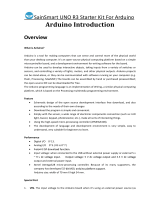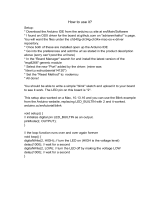Page is loading ...

Digital-to-Analog Conversion
Table of Contents
Microchip MCP4921 Features
General Overview
Serial SPI Interface
Overview
Programmable Gain Block (GA)
Voltage Reference Amplifiers (BUF)
Arduino SPI Test Script
Bipolar Operation
References:
1. 8-bit AVR Microcontroller with 4/8/16/32K Bytes In-System Programmable Flash -
ATmega328P, Chapter 23 "Analog-to-Digital Converter", ATMEL document doc8161
2. Microchip Technology Inc. MCP4921/MCP4922, 12-Bit DAC with SPI™ Interface,
Microchip Technology document DS21897B
Introduction
Before we begin watch the following instructional video on Digital Audio - you may be
surprised to discover that much of what you thought you knew about digitization is wrong.
http://www.wired.com/gadgetlab/2013/02/sound-smart-watch-this-excellent-primer-on-dig
ital-audio/
Microchip MCP4921 Features
• 12-Bit Resolution
• ±0.2 LSB DNL (typ)
• ±2 LSB INL (typ)
• Rail-to-Rail Output
• SPI™ Interface with 20 MHz Clock Support
• Fast Settling Time of 4.5 μs
• Selectable Unity or 2x Gain Output
• External VREF Input
• 2.7V to 5.5V Single-Supply Operation

General Overview
The MCP4921 is a voltage output string DAC. As shown in Figure 1, this DAC includes an
input amplifier, rail-to-rail output amplifier, reference buffer, plus shutdown and reset
management circuitry.
Figure 1 MCP4921 DAC Simplified Block Diagram
Serial communication conforms to the SPI protocol Modes 0 and 3 as defined by the
ATmega328P datasheet. The coding of these devices is straight binary and the ideal output
voltage is given by Equation 1, where G is the selected gain (1x or 2x), D
N
represents the
digital input value and n represents the number of bits of resolution (n = 12).
Equation 1 LSB Size

1 LSB is the ideal voltage difference between two successive codes. Table 1 illustrates how
to calculate LSB.
Serial SPI Interface
Overview
The MCP4921 is designed to interface directly with the Serial Peripheral Interface (SPI) port,
of the ATmega328P microcontrollers as shown in Figure 2. Your circuit should include a 0.1 μF
by-pass capacitor in order to filter high-frequency noise. The noise can be induced onto the
power supply's traces or as a result of changes on the DAC's output. The bypass capacitor
helps to minimize the effect of these noise sources on signal integrity. This capacitor should
be placed as close to the device power pin (VDD) as possible (within 4 mm). The power
source supplying these devices should be as clean as possible.
Figure 2 Arduino to MCP4921 DAC Electrical Interface
The MCP4921 is designed to interface with the Serial Peripheral Interface (SPI) port of the

ATmega328P microcontrollers in SPI Mode 0 or Mode 3 as defined in Table 2 SPI Modes
(Table 18.2 of the ATmega328P datasheet). The MCP4921 datasheet refers to these as
modes 0, 0 and 1, 1 respectively (see Figure 3).
Table 2 ATmega328P SPI Modes
Figure 3 Writing 16-bit Command/Data Word to the MCP4921 DAC
Commands and data are sent to the device via the SDI pin, with data being clocked-in on
the rising edge of SCK. The communications are unidirectional and, thus, data cannot be read
out of the MCP4921. The CS pin must be held low for the duration of a write command. The
write command/data consists of 16 bits and is used to configure the DAC’s control and data
latches. Figure 4 details the input registers used to configure and load the DACA registers.

Figure 4 Writing Command/Data Word Register
For the MCP4921 you should keep A/B bit 15 at logic zero and SHDN bit 12 at logic 1. Bits 14
(BUF) and 13 (GA), may be customized to your design solution as discussed in the next two
Sections.
Programmable Gain Block (GA)
The rail-to-rail output amplifier has configurable gain allowing optimal full-scale outputs for
differing voltage reference inputs. The output amplifier gain has two
selections, a gain of 1 V/V (GA = 1) or a gain of 2 V/V (GA = 0). The output range is ideally
0.000V to 4095/4096 * V
REF
when G = 1, and 0.000 to 4095/4096 * V
REF
when G = 2. The
default value for this bit is a gain of 2, yielding an ideal full-scale output of 0.000V to 4.096V
when utilizing a 2.048V VREF. Note that the near rail-to-rail CMOS output buffer’s ability to
approach AVSS and VDD establish practical range limitations. The output swing specification
in the Datasheet Section 1.0 “Electrical Characteristics” defines the range for a given load
condition.
Voltage Reference Amplifiers (BUF)
The input buffer amplifiers for the MCP492X devices provide low offset voltage and low noise.

A configuration bit for each DAC allows the VREF input to bypass
the input buffer amplifiers, achieving a Buffered or Unbuffered mode. The default value for
this bit is unbuffered. Buffered mode provides a very high input impedance, with only minor
limitations on the input range and frequency response. Unbuffered mode provides a wide
input range (0V to VDD), with a typical input impedance of 165 kΩ w/7 pF.
Arduino SPI Test Script
The following program is designed to read Arduino Analog Pin 0, and then convert it to a
10-bit integer using the ATmega328 ADC subsystem. This 10-bit value is then sent to the
12-bit MCP4921 DAC. This 10-bit value is left justified with respect to the 12-bit DAC data
word. This script does not use the SPI peripheral of the ATmega328. Instead it manually
shifts out the bits.
//**************************************************************//
//Name:AnalogInto12bitSPIDACMicrochipMCP4921//
//Author:GaryHill//
//Date:14March,2010//
//Version:1.0//
//Reference(s):http://www.arduino.cc/playground/Code/Spi//
//Notes:DownloadSpifolderandplacein//
//:arduino00nn/hardware/librariesfolder//
//****************************************************************
//SPIInterfaceSS_PIN(PB2),SCK_PIN(PB5),MOSI_PIN(PB3),MISO_PIN
//ArduinoPin10131112
//MCP4921DACSSSCKMOSIn/a
#include<Spi.h>
//ATmega328PADC
intanalogPin=0;//analoginputchannel
//ADCanaloginputvalue
wordsensorValue=0;//equivalenttounsignedint
//ByteofdatatooutputtoDAC
bytedata=0;
voidsetup(){
//setpin(s)toinputandoutput
pinMode(analogPin,INPUT);
}
voidloop(){
//readthevaluefromthesensor:
sensorValue=analogRead(analogPin);//commentoutthislinetotestDAC
//sensorValue=0x0200;//0x03FF=Vref,0x0200=1/2Vref
sensorValue=sensorValue<<2;//10bitADCto12bitDACword
//setSSpinlow,beginning16bit(2byte)datatransfertoDAC
digitalWrite(SS_PIN,LOW);

//sendhighbyte
data=highByte(sensorValue);
data=0b00001111&data;//clear4bitcommandfield(optional)
data=0b00110000|data;//0=DACA,0=buffered,1=1x,1=outputenabled
Spi.transfer(data);//alt:shiftOut(MOSI,SCK,MSBFIRST,data);
//sendlowbyte
data=lowByte(sensorValue);
Spi.transfer(data);//alt:shiftOut(MOSI,SCK,MSBFIRST,data);
//setSSpinhigh,completing16bittransfertoDAC
digitalWrite(SS_PIN,HIGH);
}
Bipolar Operation
source: Section 6.5 "Bipolar Operation," Microchip Technology Inc. MCP4921/MCP4922,
12-Bit DAC with SPI™ Interface, Microchip Technology document DS21897B
Bipolar operation is achievable using the MCP4921 by using an external operational amplifier
(op amp). This configuration is desirable due to the wide variety and
availability of op amps. This allows a general purpose DAC, with its cost and availability
advantages, to meet almost any desired output voltage range, power and
noise performance. Figure 5 illustrates a simple bipolar voltage source configuration. R1 and
R2 allow the gain to be selected, while R3 and R4 shift the DAC's output to a selected offset.
Note that R4 can be tied to VREF, instead of AVSS, if a higher offset is desired. Note that a
pull-up to VREF could be used, instead of R4, if a higher offset is desired.
Figure 4 Digitally-Controlled Bipolar Voltage Source.
An output step magnitude of 1 mV with an output range of ±2.05V is desired for a particular
application.
1. Calculate the range: +2.05V – (-2.05V) = 4.1V.

2. Calculate the resolution needed: 4.1V/1 mV = 4100, Since 2
12
= 4096, 12-bit resolution is
desired.
3. The amplifier gain (R
2
/R
1
), multiplied by V
REF
, must be equal to the desired minimum output
to achieve bipolar operation. Since any gain can be realized by choosing resistor values
(R
1
+R
2
), the V
REF
source needs to be determined first. If a V
REF
of 4.1V is used, solve for the
gain by setting the DAC to 0, knowing that the output needs to be -2.05V. The equation can
be simplified to:
4. Next, solve for R
3
and R
4
by setting the DAC to 4096, knowing that the output needs to be
+2.05V
/



